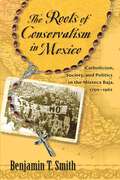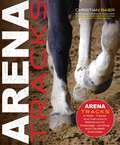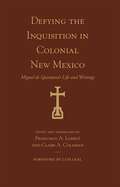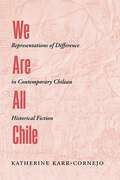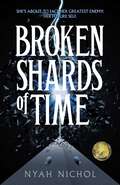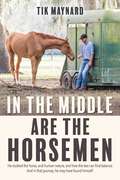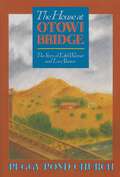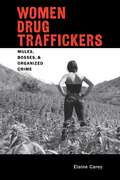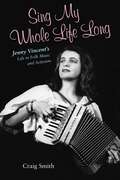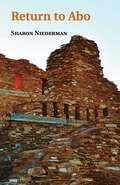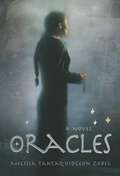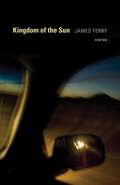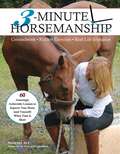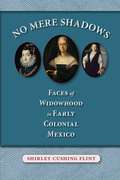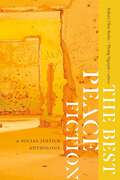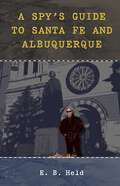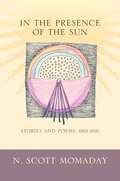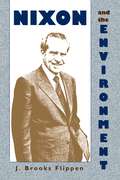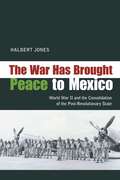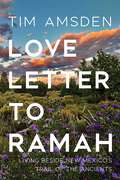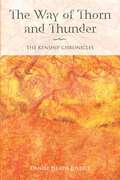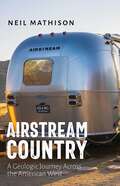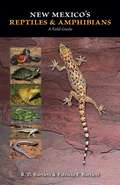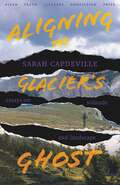- Table View
- List View
The Roots of Conservatism in Mexico: Catholicism, Society, and Politics in the Mixteca Baja, 1750-1962
by Benjamin T. SmithThe Roots of Conservatism is the first attempt to ask why over the past two centuries so many Mexican peasants have opted to ally with conservative groups rather than their radical counterparts. Blending socioeconomic history, cultural analysis, and political narrative, Smith&’s study begins with the late Bourbon period and moves through the early republic, the mid-nineteenth-century Reforma, the Porfiriato, and the Revolution, when the Mixtecs rejected Zapatista offers of land distribution, ending with the armed religious uprising known as the &“last Cristiada,&” a desperate Cold War bid to rid the region of impious &“communist&” governance. In recounting this long tradition of regional conservatism, Smith emphasizes the influence of religious belief, church ritual, and lay-clerical relations both on social relations and on political affiliation. He posits that many Mexican peasants embraced provincial conservatism, a variant of elite or metropolitan conservatism, which not only comprised ideas on property, hierarchy, and the state, but also the overwhelming import of the church to maintaining this system.
Arena Tracks
by Christian BaierThe only complete reference explaining classical arena tracks and how to use them.Rider and trainer Christian Baier has been educated in horses and equitation all over the world. In his work to develop an international rider and trainer education and certification system, he realized the equestrian lexicon lacked a practical reference that brought all the classical &“arena tracks&”
Defying the Inquisition in Colonial New Mexico: Miguel de Quintana's Life and Writings (Pasó Por Aquí Series on the Nuevomexicano Literary Heritage)
by Francisco A. Lomelí and Clark A. ColahanMiguel de Quintana was among those arriving in New Mexico with Diego de Vargas in 1694. He was active in his village of Santa Cruz de la Cañada where he was a notary and secretary to the alcalde mayor, functioning as a quasi-attorney. Being unusually literate, he also wrote personal poetry for himself and religious plays for his community. His conflicted life with local authorities began in 1734, when he was accused of being a heretic. What unfolded was a personal drama of intrigue before the colonial Inquisition.Francisco A. Lomelí and Clark Colahan dug deep into Inquisition archives to recover Quintana's writings, the second earliest in Hispanic New Mexico's literary heritage. First, they present an essay focused on Church and society in colonial New Mexico and on Quintana's life. The second portion is a translation of and critical look at Quintana's poetry and religious plays.
We Are All Chile: Representations of Difference in Contemporary Chilean Historical Fiction (Path to Open)
by Katherine Karr-CornejoA study of the relationship between literature and the current conditions of national life, We Are All Chile explores how artistic expression reflects lived experience. The book travels through figures, symbols, and events in Chilean history from the sixteenth to the end of the nineteenth centuries as represented through historical fiction of the late twentieth and early twenty-first centuries, an oeuvre that uses historical stories to reflect upon the challenges of Chilean society post-dictatorship. Contrasting the use of these stories with previous understanding highlights the power of legacies of the dictatorial authoritarian state, particularly as they shape possibilities for the full flourishing of people without regard for their minoritized or disadvantaged identities, such as their sex, sexual orientation, ethnicity, or race.This treatment of Chilean history and culture brings together literature and historiography to offer powerful interpretations of cultural narratives. The focus on varied dimensions of difference illustrates both overlapping representations and distinctive features of each within narratives imagining a more inclusive community. Throughout We Are All Chile, historical narratives and their source material are connected to support the creation of imaginative space for a better and more expansive future. The stories studied highlight the relationships between gender, empire, and the body; performances of race and gender that evoke a utopian dream of coexistence; symbols and systems of the nation as reflections of authoritarian practices; the legibility of the claims of indigenous communities; the role of violence in community building; and the strategies of lament inherent in the repeated stories of dreams for a more inclusive future shattered on the structures of exclusion. These historical narratives alone cannot change the material conditions in which people live, but they can awaken hope for the future that can inspire change. And it is this very process of defending, questioning, challenging, and changing historical stories that opens the door to possibility.
Broken Shards of Time: The Tempus Trilogy (The Tempus Trilogy)
by Nyah NicholEmbark on an epic time-traveling adventure with Broken Shards of Time, a thrilling hard science fiction novel for young adults. Wren Derecho is the lone survivor of a mysterious accident that took the lives of her parents. As Wren tries to navigate through the pain of grief and loss, she crosses paths with three other individuals and soon realizes that something beyond coincidence has intertwined their lives together. Each of their journeys is marked by immense tragedy, fate, a time machine, and a mysterious power source that seems to be alive . . . and not from this world. From the perspective of these four characters, you&’ll find the heartbeat of the story lies within the growth of love, trust and friendship developed from adventure, adversity and a common mission: to rescue their friend and save their city from an unseen yet familiar force. Wren and her team quickly discover that the hero of any story can easily become the villain. With dynamic characters and a gripping plot, Broken Shards of Time is a captivating and thought-provoking read for young adults interested in science fiction and the consequences of time travel.
In the Middle Are the Horsemen
by Tik MaynardIn 2008, 26–year–old Tik Maynard faced a crossroads not unlike that of other young adults. A university graduate and modern pentathlete, he suffered both a career–ending injury and a painful breakup, leaving him suddenly adrift. The son of prominent Canadian equestrians, Maynard decided to spend the next year as a &“working student.&” In the horse industry, working students aspire to become professional riders or trainers, and willingly trade labor for hands–on education. Here Maynard chronicles his experiences–good and bad–and we follow along as one year becomes three, what began as a casual adventure gradually transforms, and a life's purpose comes sharply into focus.Over time, Maynard evolved under the critical eyes of Olympians, medal winners, and world–renowned figures in the horse world, including Anne Kursinski, Johann Hinnemann, Ingrid Klimke, David and Karen O'Connor, Bruce Logan, and Ian Millar. He was ignored, degraded, encouraged, and praised. He was hired and fired, told he had the &“wrong body type to ride&” and that he had found his &“destiny.&” He got married and lost loved ones. Through it all he studied the horse, and human nature, and how the two can find balance. And in that journey, he may have found himself.
The House at Otowi Bridge: The Story of Edith Warner and Los Alamos (Zia Books)
by Peggy Pond ChurchThis is the story of Edith Warner, who lived for more than twenty years as a neighbor to the Indians of San Ildefonso Pueblo, near Los Alamos, New Mexico. She was a remarkable woman, a friend to everyone who knew her, from her Indian companion Tilano, who was an elder of San Ildefonso, to Niels Bohr, Robert Oppenheimer, and the other atomic scientists who worked at Los Alamos during World War II.A finely told tale of a strange land and of a rare character who united with it and, without seeming to do anything to that end, exerted an unusual influence upon all other lovers of that soil with whom she came in contact. The quality of the country, of the many kinds of people, and of the central character come through excellently. --Oliver La Farge
Women Drug Traffickers: Mules, Bosses, and Organized Crime (Diálogos Series)
by Elaine CareyIn the flow of drugs to the United States from Latin America, women have always played key roles as bosses, business partners, money launderers, confidantes, and couriers—work rarely acknowledged. Elaine Carey&’s study of women in the drug trade offers a new understanding of this intriguing subject, from women drug smugglers in the early twentieth century to the cartel queens who make news today. Using international diplomatic documents, trial transcripts, medical and public welfare studies, correspondence between drug czars, and prison and hospital records, the author&’s research shows that history can be as gripping as a thriller.
Sing My Whole Life Long: Jenny Vincent's Life in Folk Music and Activism (Counterculture Series)
by Craig SmithBorn in Minnesota and raised in Chicago, Jenny Vincent was educated at a progressive private school and Vassar College. Introduced to international folk music at an early age, she remains a performer and champion of this music of the people.In 1936, Jenny and her first husband visited northern New Mexico at the invitation of D. H. Lawrence's widow. Enchanted with the place and its people, they purchased a ranch that has been Jenny's home ever since. Jenny believed strongly in social advocacy, which she expressed through song. She performed with such luminaries as Pete Seeger, Woody Guthrie, Malvina Reynolds, and Earl Robinson, all social activists who used music as a voice for world peace, civil liberties, and human rights.Jenny and her second husband supported such causes as the Salt of the Earth strike, Native American rights, and the rising Chicano movement. Through it all Jenny raised a family and continued her music. In her nineties, Jenny continues performing, and in 2006 was honored by the University of New Mexico and the New Mexico State Historic Preservation Division for her many decades as a prominent cultural activist.
Return to Abo
by Sharon NiedermanCalled home to a funeral in Monte Alto, a small ranching community in New Mexico, journalist Maggie Chilton finds herself face to face with everything she left behind when she graduated from high school. Against the harsh beauty of the landscape and the memories it holds, three generations of women--Maggie, her mother, and her teenage daughter--struggle to make peace with each other and the land they love.What a read! Sharon Niederman has a real genius for illuminating the lives of individuals seeking one last shot at redemption in a landscape that demands too much. . . . Niederman has given us a global tale, one of place and displacement, where love and hope somehow persist whenever people dare to call a place home.--Demetria Martinez, author of Mother TongueA realistic and convincing novel. Sharon Niederman portrays the true spirit and tenacity of the women of the rural Southwest.--Linda Davis, CS Ranch, Cimarron, New MexicoI don't think I've ever read anything so real about New Mexico. Niederman gets the land, the people, the talk, the issues, the places and how they look and smell and how warm and true they are. Her powers of observation and her deep empathy and love of New Mexico ring true.--V. B. Price, author of The Oddity
Oracles: A Novel
by Melissa Tantaquidgeon ZobelIn this futuristic novel, the natural wilderness is disappearing due to human incursion and urbanization. Small pockets of nature remain and are used for tourist visits and historical interpretations. Television broadcasts pictures, sounds, and smells, and space travel is commonplace.The Yantuck Indians must find a way to preserve the natural environment that survives on their eastern United States reservation and yet participate in a global economy. This dilemma creates factions within the tribe: the Yantucks who believe in a more traditional way of life and those who seek to enhance tribal finances by marketing and selling Indian-ness, first through a casino and then a new age movement. Ashneon Quay, a young medicine woman-in-training, is herself caught between two worlds. Growing up with elderly family members, both medicine people, she attends a local college where she studies anthropology. Quay struggles to find a balance between the traditional and the new and identify a path that's right for her.Vividly rendered with strong characters and a dose of magical realism, this innovative glimpse of one Indian family trying to maintain tribal culture in the midst of rapid transformation resonates with issues Native peoples currently face.
Kingdom of the Sun: Stories
by James TerrySet in southwestern New Mexico, the stories in James Terry&’s stunning debut explore the joys, insecurities, and failures of memorable characters as they attempt to connect with—or disconnect from—others around them. The elderly landlady of the Darling Courts apartments hires a reclusive handyman who suffers from a fear of water, and the pair forms an unlikely bond. A worker&’s unscrupulous plan to build a road in the middle of the desert is threatened by a lonely pregnant woman living in a trailer parked directly in his path. Overcome by nostalgia, a married trucker making the California run from Waco to Los Angeles takes a truck-stop waitress to the Deming drive-in theater with disappointing results. Together, these surprising stories uncover how our environment manifests itself in our everyday lives.
3-Minute Horsemanship
by Vanessa BeeA book especially written for the time-starved horse owner! Do you day after day make a promise to train yourself and your horse to be better at something, but when you get to the barn there just doesn't seem to be enough time? Don't worry, what really matters is the quality of the training you do manage to fit in. It really is possible to carry out good quality, progressive training with a horse in only three minutes a day. Educator and horse trainer Vanessa Bee's light bulb moment was when she realized that if a training session had a realistic goal, every horse achieved the goal in under three minutes. This led her to create techniques appropriate for use in brief digestible lessons that ultimately produce significant gains in short sessions. This refreshing new method offers 35 ground exercises, 24 ridden exercises, and 25 real world exercises that will get you out and about with a safe, sane, well-trained horse.
No Mere Shadows: Faces of Widowhood in Early Colonial Mexico
by Shirley Cushing FlintThree generations of women in one family are the characters in this intimate historical study of what it meant to be a widow in sixteenth-century Mexico City. Shirley Cushing Flint has used archival research to tell the stories of five women in the Estrada family—a mother, three daughters, and a granddaughter—from the time of the Spanish conquest of Mexico in 1520 until the 1580s. Each was once married and when widowed chose not to remarry. Their stories illustrate the constraints placed upon them both as women and as widows by the religious, secular, and legal cultures of the time and how each refused to be bound by those constraints.Money, influence, knowledge, and connections all come into play as the widows maneuver to hold onto property. Each of their stories illustrates an aspect of Spanish life in the New World that has heretofore been largely overlooked.
The Best Peace Fiction: A Social Justice Anthology
by Robert Olen Butler Phong NguyenIn the first anthology of its kind, Robert Olen Butler and Phong Nguyen assemble an astounding collection of stories that cause readers to contemplate war, peace, and social justice in a new light. The fourteen stories featured in this volume explore the varied and often unexpected outcomes of violence. The authors explore the tragedies that occur closer to home—not on military battlefields but rather in places that are never meant to be battlefields, like schools and churches. The fiction reveals the violence that renders our most sacred and seemingly safest of places vulnerable.Not a utopian project, this book asks whether literature has a role in furthering the ongoing pursuit of peace and justice for all. While exploring tragedy, these stories also offer hope for healing, illuminating how people can move forward from the moments when their lives change and how they can regain and reshape safe spaces to find solace.
A Spy's Guide to Santa Fe and Albuquerque
by E. B. HeldWhen thinking of New Mexico, few Americans think spy-vs.-spy intrigue, but in fact, to many international intelligence operatives, the state&’s name is nearly synonymous with espionage, and Santa Fe is a sacred site. The KGB&’s single greatest intelligence and counterintelligence coups, and the planning of the organization&’s most infamous assassination, all took place within one mile of Bishop Lamy&’s statue in front of Saint Francis Cathedral in central Santa Fe.In this fascinating guide, former CIA agent E. B. Held uses declassified documents from both the CIA and KGB, as well as secondary sources, to trace some of the most notorious spying events in United States history. His work guides modern visitors through the history of such events as the plot to assassinate Leon Trotsky, Ted Hall&’s delivery of technical details of the atom bomb to the KGB, and the controversial allegations regarding Los Alamos National Laboratory scientist Dr. Wen Ho Lee&’s contacts with China.Held provides background material as well as modern site locations to allow Cold War enthusiasts the opportunity to explore in a whole new way the settings for these historical events.
In the Presence of the Sun: Stories and Poems, 1961-1991
by N. Scott MomadayIn the Presence of the Sun presents 30 years of selected works by [N. Scott] Momaday, the well-known Southwest Native American novelist. His unadorned poetry, which recounts fables and rituals of the Kiowa nation, conveys the deep sense of place of the Native American oral tradition. Here are dream-songs about animals (bear, bison, terrapin) and life away from urban alienation, an imagined re-creation based on Billy the Kid, prose poems about Plains Shields (and a fascinating discussion of their background), and new poems that utilize primary colors ('forms of the earth') to express instinctive continuities of a pre-Columbian vision.--Library JournalThe strong, spare beauty of In the Presence of the Sun is compelling evidence that Scott Momaday is one of the most versatile and distinguished artists in America today.--Peter Matthiessen. . . the images, the voices, the people are shadowy, elusive, burning with invention, like flames against a dark sky. For behind them is always the artist-author himself . . . a man with a sacred investiture. Strong medicine, strong art indeed.--The New York Times Book Review
Nixon and the Environment
by J. Brooks FlippenNo one remembers Richard M. Nixon as an environmental president, but a year into his presidency, he committed his administration to regulate and protect the environment. The public outrage over the Santa Barbara oil spill in early 1969, culminating in the first Earth Day in 1970, convinced Nixon that American environmentalism now enjoyed extraordinary political currency.No nature lover at heart, Nixon opportunistically tapped the burgeoning Environmental Movement and signed the Endangered Species Act in 1969 and the National Environmental Protection Act in 1970 to challenge political rivals such as Senators Edmund Muskie and Henry Jackson. As Nixon jockeyed for advantage on regulatory legislation, he signed laws designed to curb air, water, and pesticide pollution, regulate ocean dumping, protect coastal zones and marine mammals, and combat other problems. His administration compiled an unprecedented environmental record, but anti-Vietnam War protests, outraged industrialists, a sluggish economy, the growing energy crisis, and the Watergate upheaval drove Nixon to turn his back on the very programs he signed into law. Only late in life did he re-embrace the substantial environmental legacy of his tumultuous presidency.
The War Has Brought Peace to Mexico: World War II and the Consolidation of the Post-Revolutionary State
by Halbert JonesAlthough the battlefields of World War II lay thousands of miles from Mexican shores, the conflict had a significant influence on the country&’s political development. Though the war years in Mexico have attracted less attention than other periods, this book shows how the crisis atmosphere of the early 1940s played an important part in the consolidation of the post-revolutionary regime.Through its management of Mexico&’s role in the war, including the sensitive question of military participation, the administration of Manuel Avila Camacho was able to insist upon a policy of national unity, bringing together disparate factions and making open opposition to the government difficult. World War II also made possible a reshaping of the country&’s foreign relations, allowing Mexico to repair ties that had been strained in the 1930s and to claim a leading place among Latin American nations in the postwar world. The period was also marked by an unprecedented degree of cooperation with the United States in support of the Allied cause, culminating in the deployment of a Mexican fighter squadron in the Pacific, a symbolic direct contribution to the war effort.
Love Letter to Ramah: Living Beside New Mexico's Trail of the Ancients
by Tim AmsdenIn 1998 Tim and Lucia Amsden left their familiar lives in Kansas City and moved to the Ramah Valley in northwestern New Mexico. Love Letter to Ramah recounts their two decades of experiences there, nestled among an eclectic and diverse community of loving, earth-rooted people. It is also an evocation of the rich human and natural history permeating the area and the importance central to the traditional beliefs of Indigenous people of living in concert with the living earth.They built their house a few miles outside the tiny town of Ramah, an area where Mormons farm, old Spanish missions hunker above the bones of ancient peoples, and Native cultures abound. Beside the town runs New Mexico Highway 53, a two-lane road that meanders southwest from Grants to the Arizona border, tracing an ancient trade and exploration route that has existed for more than a thousand years.Much of New Mexico carries a strong sense of place, and that’s especially true in the Ramah area where the rich cultural tapestry, the geology and natural history, and the sky and brilliant night stars all give the land a deep and abiding energy. Many traditional Native American belief systems recognize the spiritual life of all things; in the land of the Puebloans and the Navajo, it’s easy to believe.Living in that place and within that community gave Tim and Lucia a profound and visceral understanding of our need to move the fragile blue marble of our earth back into balance. Just as important, it enhanced their awareness that we must shift ourselves into acknowledgment of and respect for our global community. It also gave them a firm belief that those things are indeed possible.
The Way of Thorn and Thunder: The Kynship Chronicles
by Daniel Heath JusticeTaking fantasy literature beyond the stereotypes, Daniel Heath Justice&’s acclaimed Thorn and Thunder novels are set in a world resembling eighteenth-century North America. The original trilogy is available here for the first time as a fully revised one-volume novel. The story of the struggle for the green world of the Everland, home of the forest-dwelling Kyn, is an adventure tale that bends genre and gender.&“Justice has created a fantasy epic so rich in history and so complex with all of its inhabitants and mystery that you&’re never going to want The Way of Thorn and Thunder to end. What a treasure for anyone looking for heroes and adventure in a series based on Aboriginal philosophy and wisdom.&” —Richard Van Camp, author of The Lesser Blessed&“The Way of Thorn and Thunder is a beautifully wrought high fantasy novel, drawing from the unique and fascinating cultures of North America&’s aboriginal peoples but successfully creating a world and characters that stand on their own, and are even set apart from what we usually see in high fantasy. Readers who enjoy meticulously created landscapes and cultures, as well as language that is by turns both visceral and elegant, will likely find much to love in The Way of Thorn and Thunder.&”—Karin Lowachee, author The Gaslight Dogs&“A powerful heroic fantasy, notable for being set, not in the familiar myth-Europe of most such fantasies, but (like Liliana Bodoc&’s haunting Saga de los Confines) in the Old World of the Western Hemisphere, the Native American world, where the true, deep roots of magic are threatened by conquest and destruction.&”—Ursula K. Le Guin
Airstream Country: A Geologic Journey Across the American West
by Neil MathisonA herd of bison standing in the snow. Layered bluffs of multicolored sandstone. A silver Airstream trailer on a mountain highway. These are familiar sights for Neil Mathison and his wife, Susan. Newly retired, their son in college, they embark upon a great American road trip &“uncoupled from the tyranny of calendars or a specific journey.&” Airstream Country recounts their travels across the western United States as they move from Montana to Malibu and Seattle to Silverton, winding their way through millions of years of geological history with their Airstream in tow. Along the way they encounter upheavals and depositions, ancient seas and young mountains, and stone towers and striated canyons, which are all illuminated by Mathison&’s knowledgeable commentary. Even after thousands of miles and eons of geology, their adventures are never finished, for, as Mathison writes, &“We learn by travel where we ought to travel more.&”
New Mexico's Reptiles and Amphibians: A Field Guide
by R. D. Bartlett Patricia P. BartlettNew Mexico is home to 165 species and subspecies of snakes, lizards, turtles, frogs, toads, and salamanders. Some are ubiquitous and others are localized. If you want basic and reliable information on the lizard in your backyard or the snake you encountered on a hike in the mountains, this handy field guide is invaluable. Both complete and concise, it includes species accounts, maps, photographs, and black-and-white drawings to help you identify the species you have encountered. In addition to basic taxonomy and a glossary, the authors have included suggestions on field protocol and legalities, as well as useful information about the various herpetofauna habitats in the state.
Flirt (Mary Burritt Christiansen Poetry Series)
by Noah BlausteinIn this stunning first collection of poems, Noah Blaustein&’s narrators face the complexities that shape a life: adolescence, fatherhood, our responsibility for the lives of others, the exhilaration of romantic love, and memory. These anxious, frequently witty poems flirt with physical danger, with grief and happiness, and with mortality as a means to transcend the mundane in our day-to-day lives. As the parent narrator says at the end of &“Rave On&”: &“This / life of mine I now know / is no longer mine to take away.&” While the narrator believes that there&’s no person &“that doesn&’t benefit from some pain,&” this evocative collection proves that life is both pain and comfort, and ends on a prayer of hope for the speaker&’s children: &“This is a prayer / for my children asleep in their bunk beds. . . . / May they never acquire / death&’s thin cello wire, / what connects my cortex to my toes, what plays / memory&’s midnight wrong song. . . . / There is beautiful music / out there. There is beautiful music.&”
Aligning the Glacier's Ghost: Essays on Solitude and Landscape (River Teeth Literary Nonfiction Prize Series)
by Sarah CapdevilleRooted in Western Montana, the essays of Aligning the Glacier's Ghost navigate how sense of place intertwines with sense of self, filling geographical and personal in-betweens of identity and illness, memory and story, and intimacy and solitude. This stunning and evocative debut gives shape to those distances, naming them as grief, narrative, and belonging. Capdeville begins the collection with one of many fissures of health, setting the stage for a lush braiding of metaphor, the body, and the natural world. In spanning the space between loss and being lost, Aligning the Glacier's Ghost outlines absence, the evolution of self, and Capdeville's foundation of place in trail work, travel, and early adulthood. Readers will find themselves enmeshed in Capdeville's reflections on how the seen and unseen interconnect to shape an inner world.
